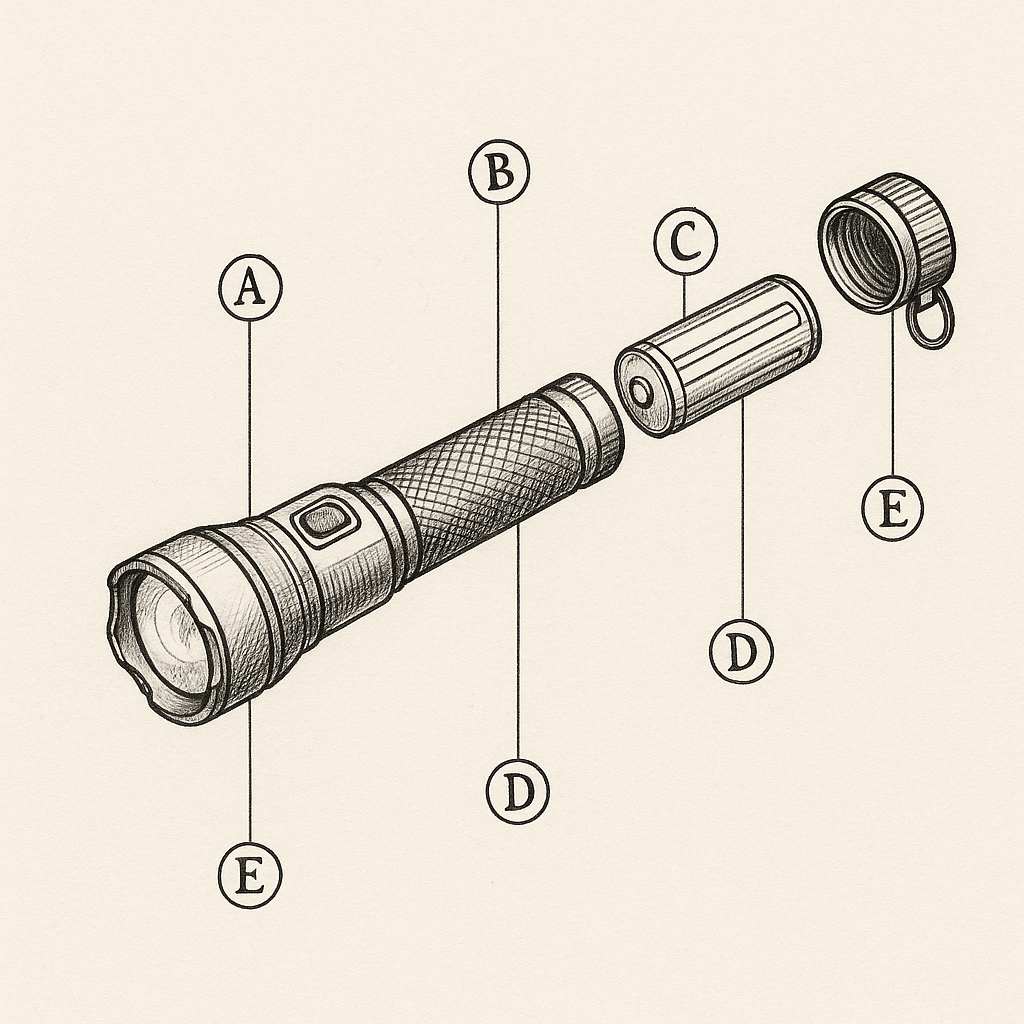Because when the power’s out or the trail’s dark, you don’t want to learn this stuff the hard way.
Portable lighting has come a long way from bulky lanterns and battery-eating plastic flashlights. Whether you're prepping for a blackout, fixing something after dark, or heading off-grid, there’s a light designed to do the job better. This guide breaks down the key types of portable lights, the features that actually matter, and how to get the most out of your lighting tools in real-world situations.
Choosing the Right Type of Portable Light
Flashlights
Best for: Focused, handheld tasks like checking fuses, navigating dark yards, or late-night pet patrols.
Why they’re great: Longer throw distance, rugged housings, and a strong beam.
Worth noting: You need one hand free to use it.
Headlamps
Best for: Hands-free jobs or movement—think winter camping, night runs, or fixing a leak under the sink.
Why they’re great: They go where you look. Most tilt, have multiple brightness modes, and keep your hands free.
Limitations: Beam range is usually shorter than flashlights.
Lanterns
Best for: Lighting up a space like a tent, workshop, or power-out room.
Why they’re great: 360° light coverage, stable base, some even double as power banks.
Downsides: Not ideal for focused or directional tasks.
Beam Patterns Explained
Spot beam: Narrow and intense. Best for long-distance visibility or signaling.
Flood beam: Wide and even. Great for close-up tasks or lighting a whole area.
Adjustable/Zoom: Lets you switch between spot and flood on the same light. Super handy for all-purpose use.
Key Features to Look For
Brightness (Lumens)
Flashlights: 150–400 lm for everyday use; 800–2000+ lm for pro/tactical jobs
Headlamps: 100–400 lm for general use; 500+ lm for technical or trail use
Lanterns: 200–600 lm for campsites; 1000+ lm for jobsite or full-room coverage
Beam Distance & Pattern
Spot = long throw
Flood = short range, wide view
Adjustable zoom = best of both worlds
Battery Type
Rechargeable (USB-C): Most convenient and cost-effective over time
Disposable: Works in a pinch, but wasteful and more expensive long-term
Hybrid: Some models can run on both
Runtime Tips
Regulated output is your friend (brightness doesn’t tank after 30 mins)
Use low mode when you don’t need max brightness—saves power and eyes
Durability
Look for higher IP ratings and drop resistance for tough conditions. Materials can affect both of these factors
Getting the Most Out of Your Flashlight or Headlamp
· Use the lowest effective brightness setting—save the battery for when you need full power
· Recharge lithium-ion lights before they’re totally drained (they last longer that way)
· In cold weather, keep your flashlight or headlamp close to your body to preserve battery life
· Clean the lens and battery contacts every so often—a little maintenance goes a long way
· Keep a backup. Even a small "losable" light is better than nothing
Recommended Lumens by Use Case
· Everyday Carry (EDC) Flashlight: 150–400 lm
· Tactical / Security Use: 800–2000+ lm
· Trail & Hiking Headlamp: 150–300 lm
· Night Running Headlamp: 300–500 lm with a wide beam
· Tent / Room Lantern: 200–400 lm
· Campsite / Jobsite Lantern: 600–1000+ lm
· Search & Rescue / Long-Throw Beam: 1000–3000+ lm
Weight & Comfort Considerations
· Headlamps: Rear battery packs help with weight balance for long wear
· Look for padded, adjustable, and breathable headbands
· Lanterns: Check for stable bases, hanging hooks, or magnetic mounts
· Flashlights: Pocket clips and grippy textures make a big difference in how often you actually carry one
Safety & Storage Tips
· Store lithium-ion batteries around 50% charge if unused for long periods
· Use lockout modes (or loosen the tail cap) to prevent accidental activation in bags
· Store spare batteries in proper cases to avoid short circuits
· Keep emergency-use lights somewhere obvious, charged, and easy to grab
Handy Extras to Look For
· Red light mode: Preserves night vision and doesn’t blind people around you
· Strobe / Beacon: Useful for roadside or search situations
· Motion Activation: Especially handy in trades or with gloves on
· Power Bank Functionality: Some lanterns can charge your phone in a pinch
· Magnetic Bases / Hooks: Let you work hands-free in tight spaces
Final Thought
You don’t have to be a flashlight nerd to benefit from having a few good lights in the right places. The key is to match the tool to the job: headlamp for hands-free, lantern for area lighting, EDC flashlight for everything else. Use them smart, keep them charged, and they’ll never let you down.
And yes, we keep one in the nightstand, one in the glove box, one in the junk drawer, and one on our heads. Because we love lighting so much, we take our work home with us—literally.

